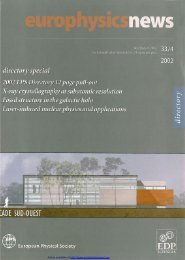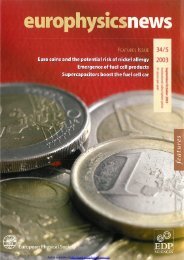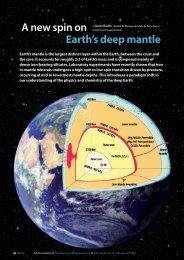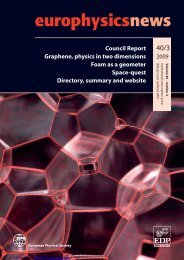PDF (11.37 MB) - Europhysics News
PDF (11.37 MB) - Europhysics News
PDF (11.37 MB) - Europhysics News
Create successful ePaper yourself
Turn your PDF publications into a flip-book with our unique Google optimized e-Paper software.
Crystal growth of colloid and (bio)macromolecular<br />
non-Kossel type systems. �ese are complex structures,<br />
with serveral crystallizing large molecules per unit cell<br />
in non-equivalent positions [7], see Fig. 2.<br />
Crystal-liquid interface<br />
Concerning point (i), it has been proposed to solve this<br />
analytically and numerically in terms of the Stefan<br />
moving-boundary (diffusion) problem. �is describes a<br />
diffusive mass and/or heat transport accross a crystalliquid<br />
(originally: ice-water) interface [8]. Many<br />
attempts have been made since the early 1960s to<br />
achieve a robust nonlinear extension of the morphological,<br />
though originally linear, crystal-involving<br />
(in)stability analysis by Mullins and Sekerka (MS)<br />
[4,5]. �e MS problem was originally treated as being<br />
driven either by a concentration gradient or by undercooling<br />
[5]. �e result of the instability analysis of the<br />
growth process has been a square-root-of-time evolution<br />
of the sphere radius, as well as an exponential time<br />
decay of its crystal-surface perturbation amplitude [4].<br />
However, none of the attempts were able to reproduce<br />
an accepted universal and robust solution to the problem<br />
of crystal-phase advancement into its ambient<br />
(solution/melt) phase, irrespective of the fact that the<br />
phenomenon had always been proposed to be diffusion-controlled<br />
[4]. Very recently, it has become clear<br />
that, for instance, (bio)macromolecular crystal formations<br />
cannot follow exclusively the diffusion-limited<br />
path. In fact, experimental evidence shows quite o�en a<br />
constant growth rate [5]. �is requires a model of massor<br />
molecular-aggregates-involving incorporation in<br />
versatile near-crystal-surface stable conditions. Such a<br />
model, while based on minimal entropy-production<br />
rate [7], is also benchmarked by the complex problem<br />
of interface-controlled growth. �e resulting growth<br />
rate is o�en analogous to the MS instability modus to<br />
a reasonable extent [4,5]. A careful analysis of such<br />
Jan CZoCHralSKi HiSTory<br />
� fig. 1: Schematics of a single “hexagonal” crystal growth for two cases. Panel a): The crystal welcomes<br />
the addition of atoms, ions or molecules which are depicted as point-like, coloured (incoming)<br />
objects. They represent, for example, different (macro)ionic species incorporated in a crystal-growth<br />
form when emerging from a solution of elecrolytic nature [6]. Panel b) represents quite the same<br />
case (be it immature and non-hexagonal) but now involving many randomly distributed nuclei that<br />
steadily try to compete for the coloured point-like (macro)ionic material, thus depleting the adjacent<br />
(white) regions. The shaded background represents an aqueous solution, whereas the coloured<br />
point-like objects are protein macroions (blue), and ionic precipitants, such as those coming typically<br />
from NaCl dissociation (in red and green, respectively), which serve to facilitate the nucleation. if the<br />
incorporation is successful, the built-in soft material becomes eventually dark and is drawn towards<br />
the round, grey objects [7]. (Courtesy of J. Siodmiak, bydgoszcz.)<br />
interfacial stochastic dynamics may inevitably lead to<br />
(non)equilibrium, mature-stage conditions of the cessation-to-growth.<br />
�ese conditions state that a crystal is<br />
formed upon some prevailing, temporary but algebraic<br />
velocity-time correlations, pointing to a flicker (i.e.,<br />
quenched) noise, residing in the interfacial zone. Otherwise,<br />
a disorderly scenario, pointing to uncorrelated<br />
(thermal) noise, prevails over its order-promoting and<br />
fairly self-organising counterpart [7].<br />
Colloid and (bio)macromolecular systems<br />
Concerning point (ii): It would have been a dream of<br />
Czochralski to have the privilege of tackling such problems<br />
(see pp. 47-66 by A.A. Chernov in [5]), including<br />
utilisation of colloid stability (e.g., in late W.A. Tiller’s<br />
works [5]).Why? First, in order to verify his expectation<br />
that biomolecules, such as lysozymes [6-7], would form<br />
single non-Kossel crystals of many polymorphic forms<br />
[6]. Second, to show that there exists a certain, though<br />
limited, structural order in their morphologies [5].<br />
� fig. 2: Cartoon of a single terrace of a model spiral-grown crystal (see drawing on the right) of width n ~ λ 0 onto which two different types of virtual<br />
constituents of the crystal are shown: hydrophobic (white balls) and hydrophilic polar (dark balls). They perform both translational and rotational<br />
random motions, preferentially along the blue-coloured terrace’s interior, but stay between the red kinks, equipped with temperature-agitated<br />
ehrlich-Schwöbel barriers [4-7]. The spiral growth illustrated on the right is often referred to as the burton-Cabrera-frank (bCf) mode.<br />
(Courtesy of J. Siodmiak, bydgoszcz; see also http://arxiv.org/abs/1103.4551.)<br />
�<br />
EPN 42/5 23










